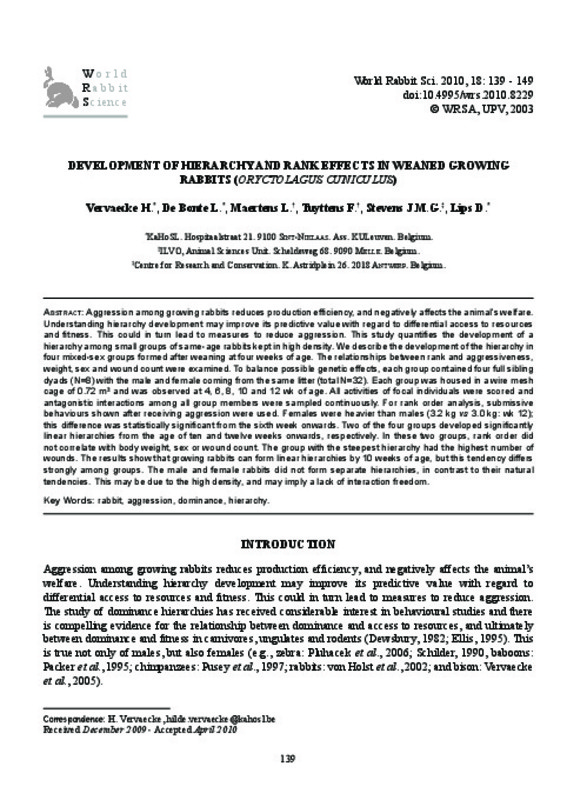JavaScript is disabled for your browser. Some features of this site may not work without it.
Buscar en RiuNet
Listar
Mi cuenta
Estadísticas
Ayuda RiuNet
Admin. UPV
Development of hierarchy and rank effects in weaned growing rabbits (oryctolagus cuniculus)
Mostrar el registro sencillo del ítem
Ficheros en el ítem
| dc.contributor.author | Vervaecke, H.
|
|
| dc.contributor.author | De Bonte, L.
|
|
| dc.contributor.author | Maertens, L.
|
|
| dc.contributor.author | Tuyttens, F.
|
|
| dc.contributor.author | Stevens, J.M.G.
|
|
| dc.contributor.author | Lips, D.
|
|
| dc.date.accessioned | 2010-11-17T09:50:44Z | |
| dc.date.available | 2012-10-17T20:00:23Z | |
| dc.date.issued | 2010-10 | |
| dc.identifier.issn | 1257-5011 | |
| dc.identifier.uri | http://hdl.handle.net/10251/8945 | |
| dc.description.abstract | [EN] Aggression among growing rabbits reduces production efficiency, and negatively affects the animal s welfare. Understanding hierarchy development may improve its predictive value with regard to differential access to resources and fitness. This could in turn lead to measures to reduce aggression. This study quantifies the development of a hierarchy among small groups of same-age rabbits kept in high density. We describe the development of the hierarchy in four mixed-sex groups formed after weaning at four weeks of age. The relationships between rank and aggressiveness, weight, sex and wound count were examined. To balance possible genetic effects, each group contained four full sibling dyads (N=8) with the male and female coming from the same litter (total N=32). Each group was housed in a wire mesh cage of 0.72 m² and was observed at 4, 6, 8, 10 and 12 wk of age. All activities of focal individuals were scored and antagonistic interactions among all group members were sampled continuously. For rank order analysis, submissive behaviours shown after receiving aggression were used. Females were heavier than males (3.2 kg vs 3.0 kg: wk 12); this difference was statistically significant from the sixth week onwards. Two of the four groups developed significantly linear hierarchies from the age of ten and twelve weeks onwards, respectively. In these two groups, rank order did not correlate with body weight, sex or wound count. The group with the steepest hierarchy had the highest number of wounds. The results show that growing rabbits can form linear hierarchies by 10 weeks of age, but this tendency differs strongly among groups. The male and female rabbits did not form separate hierarchies, in contrast to their natural tendencies. This may be due to the high density, and may imply a lack of interaction freedom. | es_ES |
| dc.language | Inglés | es_ES |
| dc.publisher | World Rabbit Science. ICTA. UPV | es_ES |
| dc.relation.ispartof | World Rabbit Science | |
| dc.rights | Reserva de todos los derechos | es_ES |
| dc.subject | Rabbit | es_ES |
| dc.subject | Aggression | es_ES |
| dc.subject | Dominance | es_ES |
| dc.subject | Hierarchy | es_ES |
| dc.title | Development of hierarchy and rank effects in weaned growing rabbits (oryctolagus cuniculus) | es_ES |
| dc.type | Artículo | es_ES |
| dc.identifier.doi | 10.4995/wrs.2010.8229 | en_EN |
| dc.rights.accessRights | Abierto | es_ES |
| dc.description.bibliographicCitation | Vervaecke, H.; De Bonte, L.; Maertens, L.; Tuyttens, F.; Stevens, J.; Lips, D. (2010). Development of hierarchy and rank effects in weaned growing rabbits (oryctolagus cuniculus). World Rabbit Science. 18(3). https://doi.org/10.4995/wrs.2010.8229 | es_ES |
| dc.relation.publisherversion | https://doi.org/10.4995/wrs.2010.8229 | |
| dc.description.volume | 18 | |
| dc.description.issue | 3 | |
| dc.identifier.eissn | 1989-8886 | es_ES |








